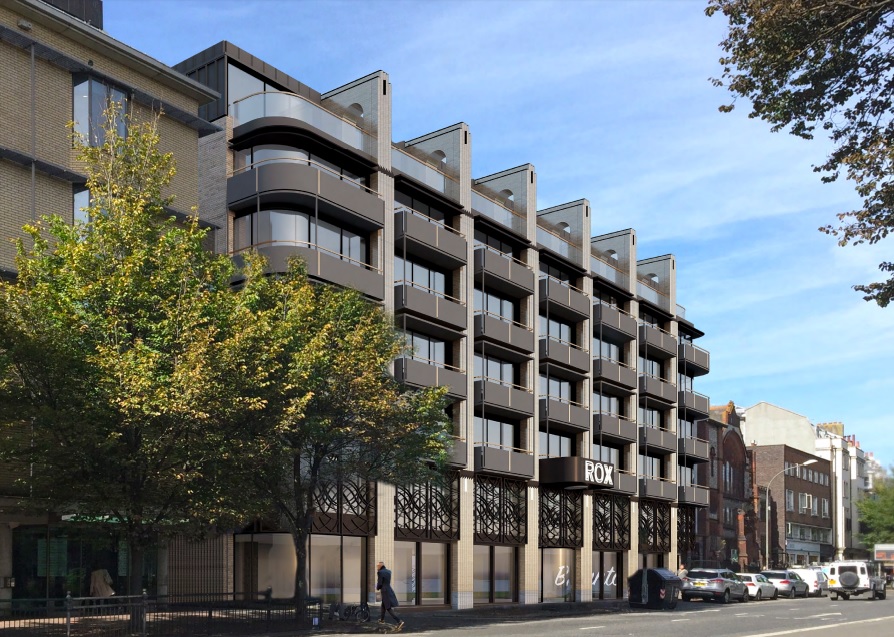
The developer of the Astoria wants to scrap the requirement it has to provide community space – partly because of reduced demand for meeting rooms since the pandemic.
The art deco cinema was demolished in to make way for a a seven storey block of flats with commercial space on the ground floor, dubbed Brighton Rox.
Because of its previous use as a cinema and bingo hall, Brighton and Hove City Council asked for some of the ground floor to be made available for the community to rent.
But Astoria Brighton – a joint venture between investment firm Cogress and developer Ktesius – has now applied for planning permission to change the use of that space to commercial, business or service.
The application says: “Since the approval there have been significant changes in the local area with the major U&I Circus Street scheme under construction and including a mix of uses including leisure and community space.
“The neighbouring building to the site (northwards) is the One Church facility which is extensively used by the community as a resource.
“Of course, there has also been the covid pandemic and as a result the demand for such uses has reduced substantially.
“As a result the owners have given further consideration to the need for a community use on the site. They do not see the merit of providing the community room only for it to remain empty and unused.
“Crucially, the owners also do not wish to compete with other local community buildings, particularly the immediately neighbouring building known as One Church which does so much excellent work in the local community.
“The applicants do recognise that there is a need to assist in some way with providing community uses in the city, and as such, one option they are considering is the possibility of making a financial contribution towards some specific improvements/repairs at One Church to ensure its continued use throughout the week, to a wide range of community groups.”
It says other nearby community spaces are at the Brighthelm Centre in North Road, the Phoenix Community Centre in Phoenix Place and the St James’s House Community Room off Edward Street.
And it notes objections from neighbours to the use of Blenheim Place as an entrance to the community space, and says if it were to be used commercially, it would be accessed from Gloucester Place.
The papers published on the council’s planning portal don’t specify how much of a contribution it might make to One Church – which is described as a “possibility”.
There is reference to correspondence with the church which contains more information, but this has not been put on the portal.
One Church has been approached for comment.







More “developers” with silly names!
How long are they reckoning on covid to last? No, they are using it as an excuse to renege on something to which they had agreed. They put greed into agreed.
Reliance on ‘One Church’ calls into question the matter of religious difference.
I went to the religious funeral of a very dear Jewish friend years ago & learned something valuable. A close muslim friend of hers attended too; but he did not enter the building. He was invited in but just shook his head. I understood.
The provision of purely secular community spaces is a sensitive way of promoting inclusivity that respects various aspects of difference.
The developer is out of order.
So he got permission under false pretences then, pretending he was going to provide a community space. How is going to compensate the community then? I’ll wait..
Typical developer’s trick
Out of interest, who manages a community space and arranges for the community to use it? How does the community even know there is a space there? Who gets any charges levied for use of the space?
* Usually a community interest company, or a public spirited local organization (church, council, charity, etc).
* Advertising.
* See first point. I worked for a Portslade outfit that did a similar thing a few years ago, and we had the unenviable position of charging below what it cost to keep the space running for community use (staff member on site, slice of maintenance/cleaning costs, IT/electricity use, insurance) and constantly got complaints that it was too expensive. People were pretty vicious about the cost, actually. The site eventually closed, with rising costs and dwindling community use being the prime drivers.
It’s possible to successfully run a community space just using unpaid volunteers. Having a staff member on site is definitely a killer in cost terms.
It was part of the terms of our insurance that we would have at least one employee on site during open hours. Volunteers could be great – we had a few absolutely sterling ones! Something like a village hall probably could run with minimal paid staffing but it wouldn’t have worked for us.
Thanks for your comments, I keep reading about community space in new buildings and it often seemed that developers wanted to reduce the space or do away with it altogether. It’s many years since I;ve had any need for meeting rooms but it always seemed to be in pubs, church halls or renting conference space at an hotel. The costs could be pretty steep for any add-ons (flipcharts, refreshments) and there were always lots of T&Cs.